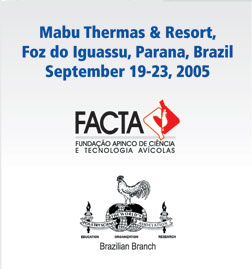Contributed Papers: Oral Presentations
Diagnosis and Epidemiology |
Molecular epidemiology
of cryptosporidiosis among human immunodeficiency
virus-infected patients in Thailand: analysis of the
18S RNA and the Cpg60/45/15 loci
Somchai Jongwutiwes1, Chaturong Putaporntip1,
Hiroji Kanbara2
1Department of Parasitology, Faculty of Medicine,
Chulalongkorn University, Bangkok 10330, Thailand
and Department of Protozoology, Institute of Tropical
Medicine, Nagasaki University, Nagasaki 852-8523,
Japan; e-mail: fmedsjw@md2.md.chula.ac.th
Diarrheal
disease caused by Cryptosporidium sp. is globally
prevalent, affecting both immunocompetent and immunocompromised
hosts. The consequences of cryptosporidiosis in human
immunodeficiency virus (HIV)-infected patients can
lead to more significant morbidity and mortality than
in individuals with normal immune status. Because
an effective anti-cryptosporidial agent is currently
unavailable, prevention of disease transmission is
of primary importance. Several epidemiological studies
indicate that human cryptosporidiosis is caused by
diverse species of Cryptosporidium, one of which deploys
exclusive anthroponotic transmission cycle and others
are considered as zoonosis. To examine the extent
of species of Cryptosporidium infecting humans in
Thailand, we recruited 67 isolates from HIV-infected
patients who sought medical treatment at King Chulalongkorn
Memorial Hospital in Bangkok during 1997-2003. Species
determination was performed by analysis of partial
sequences of the 18S RNA gene encompassing species-specific
domain and compared with those in the GenBank database.
The Cpg60/45/15 gene was used for subgenotypic analysis
of Cryptosporidium. After PCR amplification and purification,
sequences were determined directly from the PCR-amplified
products and/or from subclones, which were done from
both directions. Results revealed that the 18S RNA
genes defined 8 sequence types belonging to C. hominis
(38.6%), C. meleagridis, (28.6%), C. parvum, (12.9%),
C. canis, (10%), C. felis, (2.8%), C. muris, (1.4%),
Cryptosporidium Pig1 genotype (1.4%), and a novel
sequence (4.3%). Mixed infections between C. hominis
and C. meleagridis were observed in 3 isolates (4.3%).
Phylogenetic construction has placed the novel sequence
type of the 18S RNA gene close to that from an environmental
isolate from water in USA. Meanwhile, PCR amplification
targeting the Cpg65/45/15 gene of Cryptosporidium
was successful for C. hominis, C. parvum and C. meleagridis,
while the rest yielded negative results. The Cpg64/45/15
sequences obtained from C. hominis belonged to groups
Ia, Id, and Ie, while those from C. parvum displayed
a novel type II sequence and all C. meleagridis in
this study possessed type IIIa sequence. Sequence
comparison with those previously reported showed that
the Cpg65/45/15 gene was highly polymorphic, rendering
it an attractive marker for subgenotyping or strain
differentiation of C. hominis, C. parvum and C. meleagridis.
In addition, no significant correlation between species
or subgenotypes of Cryptosporidium and clinical symptoms
of the patients was found in this analysis. Hence,
human acquisition of Cryptosporidium can plausibly
be from diverse sources and the zoonotic transmission
cycles of this coccidian protozoan in Thailand are
common among HIV-infected patients.
